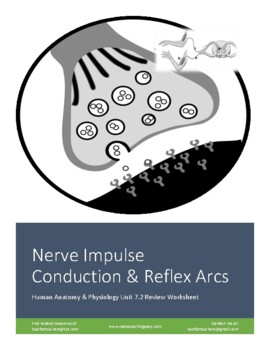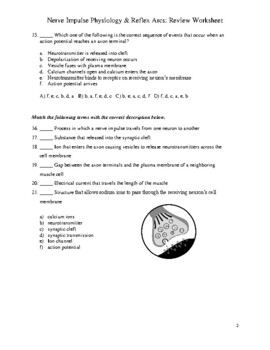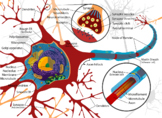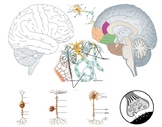Nerve Impulse Physiology (Action Potentials) & Reflex Arcs (Virtual Friendly)
- PDF
- Easel Activity
- Easel Assessment
Also included in
- Make teaching Anatomy & Physiology easy with this Human Anatomy & Physiology Bundle: The Nervous System. Differentiation and literacy strategies are incorporated and noted in the detailed unit plan. Easily accessible resources (videos, worksheets... are highlighted and linked. Use as anPrice $19.99Original Price $28.93Save $8.94
- Make teaching Anatomy & Physiology easy with this Human Anatomy & Physiology worksheet bundle. Each worksheet is in an easy to grade format. Answer keys are provided! This bundle includes:Human Anatomy & Physiology Unit 7.1 Review Worksheet: Nervous Tissue Structure and FunctionHumanPrice $9.99Original Price $15.75Save $5.76
- Make teaching Anatomy & Physiology super easy with this highly requested anatomy course growing bundle! SIOP, gifted, and differentiation strategies are embedded and easily identified throughout each unit plan. Lessons are differentiated according to learning style, grouping, and language abilPrice $332.80Original Price $446.97Save $114.17
Description
Make teaching easier with the Human Anatomy & Physiology Unit 7.2 Review Worksheet: Nerve Impulse Physiology & Reflex Arcs
Lesson Objectives: This worksheet will help students understand:
- Describe theh events that lead to the generation of a nerve impulse andn its conductin from one neuron to another.
- Describe the vents ocurring during synaptic transmission.
- Define and list the elements of a reflex arc.
- Differentiate between somatic and autonomic reflexes.
Materials:
- Student handouts
- Teacher answer key
- Notes or textbook (optional)
Questions are in easy to grade format, matching, multiple choice. Use this as a lesson review or as an introduction to the nervous system. Teacher answer key is provided. Easy for teachers to grade, students can answer on their own paper, on a scan sheet, or on the worksheet provided.
For other great resources to make teaching easier follow me for updates! If you like my product, don't forget to write a review! Thank you!
www.maketeachingeasy.com
Email me at bestforteachers@gmail.com
Use this review sheet alone or get the entire Human Anatomy & Physiology Unit 7 Growing Bundle! This bundle includes: (available items highlighted in blue link)
- Human Anatomy & Physiology Unit Plan 7: The Nervous System
- Human Anatomy & Physiology Unit 7 PPT: The Nervous System
- Human Anatomy & Physiology Unit 7.1 Review Worksheet: Nervous Tissue Structure and Function
- Human Anatomy & Physiology Unit 7.2 Review Worksheet: Nerve Impulse Physiology & Reflex Arcs
- Human Anatomy & Physiology Unit 7.3 Review Worksheet: The Central Nervous System (Brain & Spinal Cord)
- Human Anatomy & Physiology Unit 7.4 Review Worksheet: The Peripheral Nervous System (Cranial and Spinal Nerves)
- Human Anatomy & Physiology Unit 7.5 Review Worksheet: The Autonomic Nervous System
- Unit 7 Test: The Nervous System (Free Bonus File!)
The Unit Plan
Make teaching Anatomy & Physiology easy with this combined unit and daily lesson plan that covers 8 blocks or 14 periods of a secondary A & P course. SIOP, gifted, and differentiation strategies are embedded and easily identified throughout. Lessons are differentiated according to learning style, grouping, and language ability. Both content and literacy standards as well as key vocabulary words, essential questions, activating strategies, instructional strategies, and summarizing strategies are included and highlighted.
Upon completion of this unit, students will be able to:
Content Standards:
SAP3: Students will assess the integration and coordination of body functions and their dependence on the endocrine and nervous systems to regulate physiological activities..
- Interpret interactions among hormones, senses, and nerves which make possible the coordination of functions of the body.
- Investigate the physiology of electrochemical impulses and neural integration and trace the pathway of an impulse, relating biochemical changes involved in the conduction of the impulse.
- Describe how the body perceives internal and external stimuli and responds to maintain a stable internal environment, as it relates to biofeedback.
Literacy Standards:
- L11-12RST2: Determine the central ideas of conclusions of a text; summarize complex concepts, processes, or information presented in a text by paragraphing them in simpler but still accurate terms.
- L11-12RST3: Follow precisely a complex multistep procedure when carrying out experiments…
Content Objectives (TSWBAT):
- List the functions of the nervous system and explain the structural and functional classifications of the nervous system.
- Define central nervous system and peripheral nervous system, and list the major parts of each.
- Describe the structures and functions of neurons and neuroglia.
- Describe the general structure of a neuron, and name its important anatomic regions.
- Describe the composition of gray matter and white matter.
- Classify neurons according to structure and function.
- List the types of general sensory receptors and describe their functions.
- Identify and indicate the functions of the major regions of the cerebral hemispheres, diencephalon, brain stem, and cerebellum on the human brain model or diagram.
- Name the three meningeal layers, and state their functions.
- Compare the signs of CVA with those of Alzheimer’s disease; of a contusion with those of a concussion.
- Define EEG, and explain how it evaluates neural functioning.
- List two important functions of the spinal cord and describe its structure.
- Describe the general structure of a nerve.
- Identify the cranial nerves by number and by name.
- Describe the origin and fiber composition of ventral and dorsal roots, the spinal nerve proper, and ventral and dorsal rami.
- Name the four major nerve plexuses, and describe their distribution.
- Identify the site of origin, and explain the function of the sympathetic and parasympathetic divisions of the nervous system.
- List factors that may harm brain development.
- Describe spinal bifida, anencephaly, and cerebral palsy.
- Explain how brain size and weight declines with age.
- Define senility and list possible causes.
Language Objectives:
- Discuss the formation and function of the cerebrospinal fluid and the blood-brain barrier.
- Read clinical case studies of homeostatic imbalances of the nervous system.
- Write, discuss, and use key vocabulary appropriately.
Key Vocabulary: nervous system, sensory input, integration, motor output, central nervous system (CNS), peripheral nervous system (PNS), sensory (afferent) division, motor (efferent) division, somatic nervous system, voluntary nervous system, autonomic nervous system (ANS), involuntary nervous system, neuroglia, glia, astrocytes, microgila, ependymal cells, oligodendrocytes, Schwann cells, satellite cells, neurons, cell body, Nissl bodies, neurofibrils, dendrites, axons, axon hillock, axon terminal, neurotransmitters, synaptic cleft, synapse, myelin sheath, neurilemma, nodes of Ranvier, multiple sclerosis (MS) ganglia, tracts, white matter, gray matter, sensory neurons, afferent neurons, cutaneous sense organs, proprioceptors, motor (efferent) neurons, sensory (afferent) neurons, multipolar neuron, bipolar neuron, unipolar neuron, polarized, depolarization, graded potential, action potential, nerve impulse, repolarization, reflex, reflex arc, somatic reflex, autonomic reflex, cerebral hemispheres, cerebrum, gyri, sulci, fissures, lobes, cerebral cortex, primary somatic sensory area, parietal lobe central sulcus, sensory homunculus, occipital lobe, temporal lobe, primary motor area, pyramidal tract, corticospinal tract, motor homunculus, Broca’s area, anterior association area, posterior association area, speech area, cerebral white matter, corpus callosum, basal nuclei, diencephalon, thalamus, hypothalamus, limbic system, pituitary gland, mammillary bodies, epithalamus, pineal gland, choroid plexus, brain stem, midbrain cerebral aqueduct, cerebral peduncles, corpora quadrigemina, pons, medulla oblongata, fourth ventricle, reticular formation, reticular activating system (RAS), cerebellum, meninges, dura mater, falx cerebri, tentorium cerebelli, ataxia, arachnoid mater, subarachnoid space, pia mater, arachnoid granulations, cerebrospinal fluid, ventricles, hydrocephalus, blood-brain barrier, concussion, contusion, intracranial hemorrhage, cerebral edema, cerebrovascular accidents (CVAs), hemiplegia, aphasias, transient ischemic attack (TIA), spinal cord, cauda equine, dorsal horns, posterior horns, ventral horns, anterior horns, central canal, dorsal root, dorsal root ganglion, ventral root, spinal nerves, flaccid paralysis, dorsal column lateral column, ventral column, spastic paralysis, peripheral nervous system (PNS), endoneurium, perineurium, fascicles, epineurium, sensory (afferent) nerve, motor (efferent) nerve, mixed nerve, cranial nerve spinal nerve, dorsal ramus, ventral ramus, plexuses, preganglionic neuron, preganglionic axon, postganglionic axon, sympathetic division parasympathetic division, craniosacral division, terminal ganglion, thoracolumbar division ramus communicans, sympathetic trunk ganglion, sympathetic trunk (chain), splanchnic nerve, collateral ganglion, cerebral palsy, anencephaly, spina bifida, orthostatic hypotension, arteriosclerosis, and senility
I would love to hear from you! I am in the process of uploading related resources. Look for the entire Human Anatomy Course Unit set as they become available soon! If there is anything you would like to see prioritized, please let me know! If you like my product, don't forget to write a review!
Than you for shopping Best for Teachers!
Check out my EXERCISE AND NUTRITOIN PLANS FOR TEACHERS ON TPT OR VISIT MY WEBSITE AT REVERSAGE HEALTH & FITNESS! Download my free 1 Week sample Vegetarian Meal Plan for a summer jumpstart weight loss cleanse!









